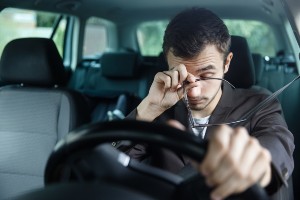Dangers of Fatigued Driving

Drowsy driving, also known as fatigued driving or driver fatigue, is a dangerous driving behavior that can result in very serious consequences.
- Drowsy driving accounts for about 100,000 crashes annually on the roadway, 71,000 injuries, and 1,550 fatalities per year [NSC]
- According to data from AAA’s Foundation for Traffic Safety report, drowsy driving caused 29,834 traffic fatalities between 2017-2021, with 6,726 occurring in 2021 alone.
- Statistics show an estimated 17.6 percent of fatal car crashes between 2017 and 2021 involved a drowsy driver (AAA Foundation)
- 693 deaths from drowsy-driving-related crashes in 2022 (NHTSA)
Source of Statistics
Drowsy Driving is Impaired Driving
Drowsy driving mirrors drunk driving in many ways: blurred vision, slowed reaction time and poor decision-making.
- If you are awake for 18 hours straight, your driving will be similar to that of a driver with a blood alcohol concentration (BAC) of .05 (where .08 is considered drunk); at 24 hours, that increases to the equivalent of a driver with a BAC of .10. (Sleep Foundation)
- Drivers’ reaction times, awareness of hazards, and ability to sustain attention all worsen the drowsier the driver is.
- The negatives of drowsy driving include impaired cognition and performance, motor vehicle crashes, workplace accidents, and health consequences.
- Drowsiness or fatigue can cause drivers to experience “tunnel vision” (when you lose sense of what’s going on in the periphery).
- Drowsiness or fatigue can cause microsleeps (brief sleep episodes lasting from a fraction of a second up to 30 seconds).
When you have questions, we are here to help. Call us at (877) 284-6600.
Who is Most Likely to Drive Drowsy
Drowsy driving is more common in those who travel long distances, such as truck drivers; however, anyone can suffer from drowsiness or driver fatigue while at the wheel. Many drivers may not even realize they are suffering from fatigue because the signs can be subtle.
Warning Signs to Watch out for:
- Frequent yawning or difficulty keeping your eyes open
- “Nodding off” or having trouble keeping your head up
- Inability to remember driving the last few miles
- Missing road signs or turns
- Difficulty maintaining your speed
- Drifting out of your lane
 At-Risk Groups for Drowsy Driving
At-Risk Groups for Drowsy Driving
- Young and inexperienced drivers who have had less time on the road and are less skilled at driving.
- Shift workers and those with extended hours are typically extremely tired when it is time to clock out since they tend to work long hours. Those who work nights, rotating or double shifts have six times the risk of drowsy driving than other types of workers.
- Commercial drivers are at a higher risk of drowsy driving since they typically are driving long hours to meet a deadline.
- Business travelers are subject to jet lag and changing time zones.
- People with sleep conditions, such as narcolepsy, insomnia, untreated obstructive sleep apnea are at a higher risk of drowsy driving.
How Often do People Drive While Drowsy?
- About 27% of drivers report driving while being so tired they have difficulty keeping their eyes open. [AAA]
- 1 in 25 drivers admit to falling asleep behind the wheel. [CDC]
- 47% of those who have nodded off while driving did so on a trip lasting one hour or less. [NHTSA]
Source of Statistics
Helping You Stay Alert
- Know the signs of drowsiness
- Take frequent breaks. On long trips, stop at least every 100 miles or every 2 hours.
- When possible, switch drivers.
- Get a good night’s sleep before a long drive.
- Avoid driving during the mid-afternoon and between midnight to 6:00 a.m
- Pull over and take a nap
- Pay attention to medication (prescription and over the counter) warning labels
- Avoid caffeine during the last half of your day as it can contribute to sleep problems.
SERIOUSLY INJURED IN A Fatigued Driving Accident?

Consult an attorney who knows how to handle motor vehicle accidents.
Each driver has a legal obligation (or “duty of care”) to look out for the safety of other drivers, pedestrians and other individuals. When a driver fails this, negligence has taken place and the at fault party may be held liable for damages and injuries caused.
Having an attorney who is your advocate can offer you peace of mind during your recovery. We have a successful track record of helping accident victims collect the compensation they deserve. Our attorneys can:
- Investigate the cause of your accident, gather evidence and identify all responsible parties
- Document your damages to maximize the value of your personal injury claim
- File insurance claims and handle all communication with the insurance company
- Calculate the correct value of your injury claim
- Monitor all deadlines under the statutes of limitations
- File a personal injury lawsuit, if necessary
WHAT OUR CLIENTS ARE SAYING
CALL NASH & FRANCISKATO FOR A FREE NO-OBLIGATION CASE REVIEW
Have you or a loved one been seriously injured in a motor vehicle accident with a drowsy, or fatigued, driver? Call the Kansas City-based law firm of Nash & Franciskato at (877) 284-6600.
One of our experienced staff will speak with you personally and will provide you with a free, no-obligation case evaluation.
START YOUR FREE CASE EVALUATION TODAY
RESOURCES FOR YOU
If you would like to receive news and blog updates on a regular basis, sign up to receive our email newsletter. Your email address will only be used to send you our newsletter and respond to inquiries.
SIGN UP FOR NEWSLETTER
Past results afford no guarantee of future results and each case is different and is judged on its own merits. The choice of a lawyer is an important decision and should not be based solely on advertisements.
Editor’s Note: This post was originally published on August 20, 2020. It was reviewed on August 9, 2022, updated for content and accuracy and again on November 5, 2024.
Related

 At-Risk Groups for Drowsy Driving
At-Risk Groups for Drowsy Driving